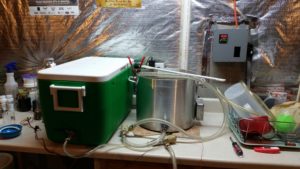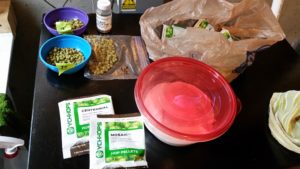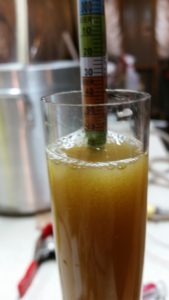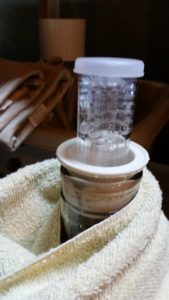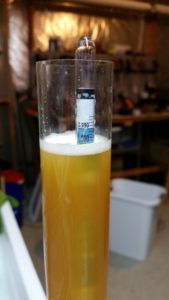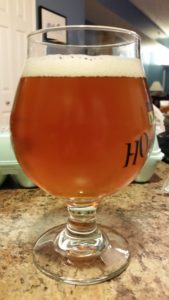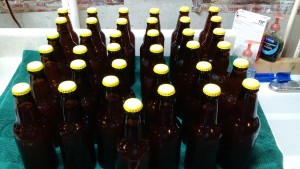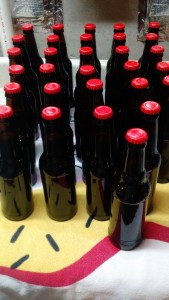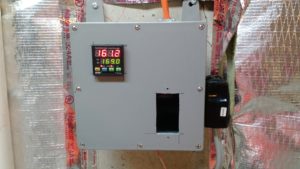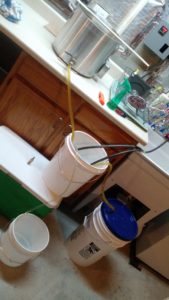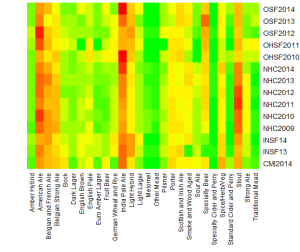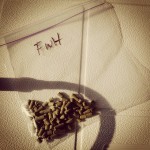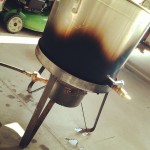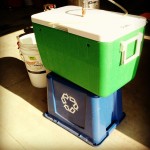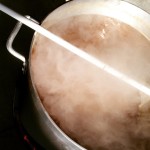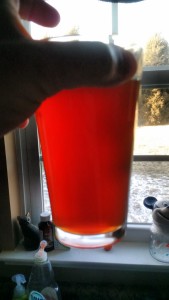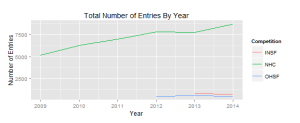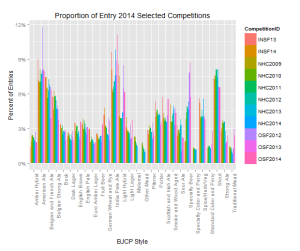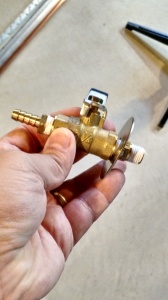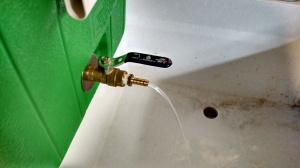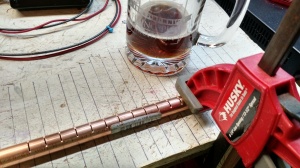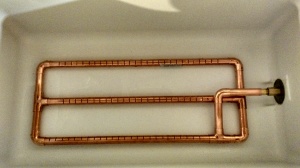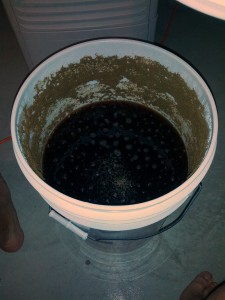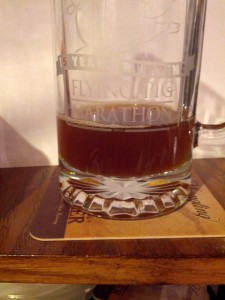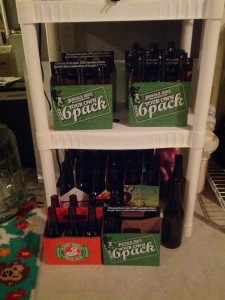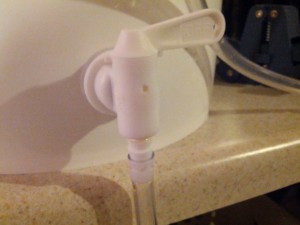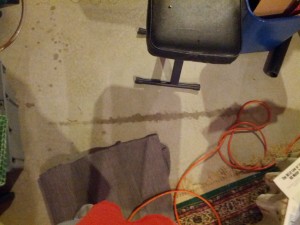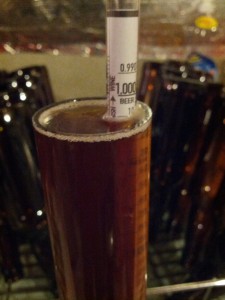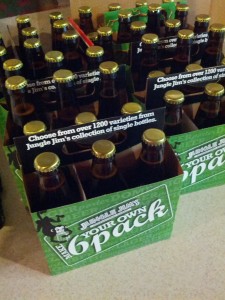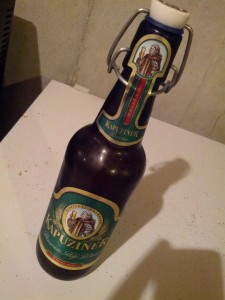Tag Archive: homebrewing
Imperial Hoptrooper Brew Day and Tasting Notes
On November 20, I brewed my biggest (and most successful in terms of numbers) beer – a double IPA. Recipe inspiration came from MadTree’s High series, which is a series of IIPAs that are quite popular and very well rated (note: there are three “highs” that I know of, the Galaxy and Citra, which are linked in the text, and Azacca which is not… but it’s also f**king tasty! There may have also been a Mosaic High).
The recipes are similar. I did a fair bit of ‘back of the napkin’ analysis on the two beers, looking at the percentages of grain, the AAU at each addition, etc. I ended up with the recipe below.
Recipe Details
| Batch Size | Boil Time | IBU | SRM | Est. OG | Est. FG | ABV |
|---|---|---|---|---|---|---|
| 5.5 gal | 60 min | 123.7 IBUs | 5.9 SRM | 1.074 | 1.014 | 7.8 % |
Style Details
| Name | Cat. | OG Range | FG Range | IBU | SRM | Carb | ABV |
|---|---|---|---|---|---|---|---|
| Double IPA | 22 A | 1.065 - 1.085 | 1.008 - 1.018 | 60 - 120 | 6 - 14 | 2.4 - 2.9 | 7.5 - 10 % |
Fermentables
| Name | Amount | % |
|---|---|---|
| Pilsner (Hoepfner) | 10.5 lbs | 72.41 |
| Vienna Malt (Briess) | 2.25 lbs | 15.52 |
| Caramel/Crystal Malt - 40L | 8 oz | 3.45 |
| Carapils (Briess) | 4 oz | 1.72 |
| Corn Sugar (Dextrose) | 1 lbs | 6.9 |
Hops
| Name | Amount | Time | Use | Form | Alpha % |
|---|---|---|---|---|---|
| El Dorado | 1 oz | 60 min | Boil | Pellet | 15 |
| Galena | 1 oz | 60 min | Boil | Pellet | 12.5 |
| Centennial | 0.5 oz | 30 min | Boil | Pellet | 10 |
| Mosaic (HBC 369) | 0.5 oz | 30 min | Boil | Pellet | 12.3 |
| Centennial | 0.5 oz | 15 min | Boil | Pellet | 10 |
| Mosaic (HBC 369) | 0.5 oz | 15 min | Boil | Pellet | 12.3 |
| Centennial | 1 oz | 15 min | Aroma | Pellet | 10 |
| Mosaic (HBC 369) | 1 oz | 15 min | Aroma | Pellet | 12.3 |
| Centennial | 2 oz | 0 min | Dry Hop | Pellet | 10 |
| Mosaic (HBC 369) | 2 oz | 0 min | Dry Hop | Pellet | 12.3 |
| Chinook | 1.5 oz | 0 min | Dry Hop | Pellet | 13 |
| Citra | 1 oz | 0 min | Dry Hop | Pellet | 12 |
Mash
| Step | Temperature | Time |
|---|---|---|
| Mash In | 152°F | 60 min |
Download
| Download this recipe's BeerXML file |
I kept closer to the size of the Citra High recipe, mostly because I am still working through efficiency issues (it’s getting better, though). I still didn’t get MadTree’s efficiency, but to be fair, I’m targeting 75%, not 82%!
Brew Day
I’m happy to say that the only issues during brew day was how long it took and higher than expected grain absorption. I started later in the day (around 2:30 PM) and it didn’t end until maybe 6:30PM. There were no stuck sparges, clogged lines or chillers, boil boiled. I ended up with about 4.5 gallons into the fermenter, which is less than the 5.5 gallons I was targeting. However, the lower volume works better with my 7.5 – 8 gallon kettle.
Throughout fermentation, the temperature (as measured on the side of the fermenter) stayed at 68, which is a nice perfect temperature.
Tasting Notes
Aroma: Grapefruit mostly
Appearance: Copper, opaque. White head that starts thick and persists as a thin head.
Taste: Tongue lashing bitterness with citrus tones. Some alcohol flavor.
Mouthfeel: Moderately carbonated, slight citrusy tartness lingers past the dry finish.
Overall Impression: I’m biased, but I love this beer. I’ve been drinking the heck out of this!
OG: 1.071
SG: 1.005
ABV: 8.7%
IBU: 124
SRM: 6
What’s Next With This Recipe?
I want to try two things – one is maybe a little less bitterness. The other is honey instead of sugar. I’m wondering if some Orange Blossom honey would work well with the citrus based hops.
Cheers!
Blogging Lull (but not a homebrewing lull)
I logged in to this blog today with the intent to post something. I have five drafts started, but none of them are finished. And I somehow doubt that I’ll finish any of them soon.
Lots of stuff going on:
- I bottled my first lager a few weeks ago
I LOVE the flavor – it’s everything I wish American Lagers were. It has a slightly sharp citrus flavor that makes me feel like it’s summer when I’m drinking it. Unfortunately, it’s undercarbonated. I can’t seem to find any style for it in BJCP, so it might be in 34B or 34C in the next competition, because even if undercarbonated I think it’s worth getting some comments from the judges (especially because it’s clean). I have two more beers for that competition. I’m absolutely going to get beers into this one since I missed the last one. - I bottled a black IPA
I haven’t tasted this one in a carbonated form, but it took FOREVER to ferment. I had issues with my mash temperature, I used lactic acid for the first time (to bring the strike and sparge water down to a pH of 5.5), fermenting initially stalled at 1.030 (from 1.062), and the temperature in my basement fell to 60º F. Some of the tastes had a very harsh bitterness, but that fermented out (thank God!). I think it’ll be good enough, but I’m not sure if I’m going to enter it into the next competition. - I chased a WHALEZBRO
Local brewery MadTree released a BBA/Red Wine Barrel Aged Rubeus Cacao. Given work meetings, a conference call, a run over lunch, it was tight but I made it… and man, I haven’t ran that fast on a training run in a long time! The beer, BTW, was excellent! - Grain Absorption
I learned to keep copious notes since I was having some difficulty hitting my mash temperatures. I decided to log everything I could think of. In looking back in the last few logs, I found that my grain was absorbing A LOT more than BeerSmith’s default 0.96 fluid ounces of strike water per ounce of grain. In fact, I’m around 1.4720 fluid ounces per ounce of grain. In searching for this on Google, this number is not out of line, but it does mean more sparge water (I find it slightly interesting, although not wrong, that it has no effect on strike water volume). - Mash Tun Modification
Since I tend to feel like I religiously have a stuck sparge, I cut my mash manifold slots deeper and added a few more. Of course because of that, I’m going to continue to monitor the grain absorption to see if I need to make on-the-fly adjustments. - Expansions
I just looked on the “Where’s My Refund” tool and found that my Federal refund is due in a few days. As soon as it hits the account, I’m buying kegs. I’m also going to buy another boil tun (going with a 10 gallon instead of an 8 gallon). Lastly, I’m going to buy a few more fermenters. The current one may become a sours fermenter. - Science!
I ordered an inexpensive eBay China special microscope. It’s a waste of money. I started a post, but I have a few things to do before it is ready. The tl;dr: “buy a real microscope, don’t skimp on cheap crap from China”. The other tl;dr: “You can’t see yeast with something you paid less than $20 for”. - MOAR BREWING!!!
I have three or four or five things I want to brew, including an IPA (of course!), a saison, an American wheat (or maybe a hefeweizen), a berlinerweisse, and a Vienna lager. I am going to run in to an issue with controlling fermentation temperatures and having a kegerator. I have ideas, but nothing that I’ve done… yet. - This Weekend in Beer Drinking
I may start posting something weekly about notable beers I’ve drunk. This could get interesting. - Running
I’ve managed to keep my injuries at bay since before Christmas and I registered for the Moerlein Beer Series for the fourth year in a row. I’ve made some changes nutrition-wise that may mean that I can keep things together (pun intended!) permanently.
Another IPA Brew Day
So I decided later than usual on a Saturday to brew. This is a brew that I wanted to do the prior weekend, but my home AC was on the fritz and adding a bunch of humidity to it would not have been a very smart move.
This was an interesting brew day for two reasons. A large portion of the brew day was spent thinking that I would be preparing to brew the following day. I built an electric panel to fix the dangerous setup I had previously.
The thing is, I didn’t have the plug on the cord from the boiler ready. Once I did that, I added water and started things up. Then I went to work on preparing the mash tun. In my last post, I had the stuck sparge from Hell. I did NOT want that happening again. I added some plumbing solder in some strategic places and scrubbed down the copper. At that point (and after messing up and fixing solder joints twice, and since leaks don’t really matter here the mess ups were pretty important to fix), I decided to go ‘all in’ and start mashing.
I love problems that fix themselves!
This brew day had one minor mess up – for my IPA, I have hops at first wort (in the kettle), 15, 5, knockout, and dry. I did first wort, 15, 10, and knockout. Oops. It also had one issue that I thought would be a huge problem – my sparge water kept heating even after the PID said things were off. I didn’t notice until the water hit 205º F, and the heat was still on despite the output light on the PID controller not being on. So I unplugged the boiler to keep the water from boiling and let it cool. Later, when it was time to heat the water back up to sparge temperatures, I plugged the boiler back in and let it heat back up. And it worked correctly. And it worked correctly through the entire boil, too. I love problems that fix themselves!
They leak
Chilling had been an issue in the past, and I still reign supreme at having the most fucked up chilling schemes. This one isn’t much different. I bought a plate chiller on Amazon a few weeks ago. The water inlets and outlets were standard hose fittings. My house is six years old, and the cheap washing machine lines were something that was on the list of things to replace. I decided to purchase new stainless steel lines for the washing machine and use the old lines for the plate chiller.
They leak. Somehow in the process of unhooking them from the back of the washing machine and the wall and putting them on the plate chiller, they decided to leak. And these weren’t leaks that could be fixed by torquing down the connectors or using pipe tape (which is unnecessary on these connectors). And I made sure the O-rings were in the hose connectors.
So I did what any sane person would do. Since I didn’t have enough hose to set the plate chiller in the sink (that would have been optimal), I put the chiller in a bucket. Which started to fill. So to avoid flooding part of my basement, I used a small hose to siphon the leaking water out of the main bucket into another so I could dump water without moving the plate chiller around.
So on the shopping list is two new hoses. Because had I had not-leaking hoses, the plate chiller would have worked very well. And even allowing a lot of the trub go through was okay (I use pellet hops). I’m not sure what temperature I got things down to. Put the ale pail into the fermentation chamber and set it to chill at about 6:30. I ended up pitching the yeast at midnight or so.
The Recipe
The recipe has changed a little. I wanted it a little less malty and a little more crisp.
Recipe Details
| Batch Size | Boil Time | IBU | SRM | Est. OG | Est. FG | ABV |
|---|---|---|---|---|---|---|
| 5 gal | 60 min | 71.4 IBUs | 5.4 SRM | 1.070 | 1.013 | 7.6 % |
| Actuals | 1.051 | 1.01 | 5.4 % | |||
Style Details
| Name | Cat. | OG Range | FG Range | IBU | SRM | Carb | ABV |
|---|---|---|---|---|---|---|---|
| American IPA | 14 B | 1.056 - 1.075 | 1.01 - 1.018 | 40 - 70 | 6 - 15 | 2.2 - 2.7 | 5.5 - 7.5 % |
Fermentables
| Name | Amount | % |
|---|---|---|
| Pale Malt (2 Row) US | 7 lbs | 50 |
| Vienna Malt | 6 lbs | 42.86 |
| Cara-Pils/Dextrine | 1 lbs | 7.14 |
Hops
| Name | Amount | Time | Use | Form | Alpha % |
|---|---|---|---|---|---|
| Cascade | 2 oz | 15 min | First Wort | Pellet | 6.6 |
| Cascade | 0.5 oz | 15 min | Boil | Pellet | 6.6 |
| Citra | 0.5 oz | 15 min | Boil | Pellet | 12 |
| Galaxy | 0.5 oz | 15 min | Boil | Pellet | 11 |
| Cascade | 0.5 oz | 5 min | Boil | Pellet | 6.6 |
| Citra | 0.5 oz | 5 min | Boil | Pellet | 12 |
| Galaxy | 0.5 oz | 5 min | Boil | Pellet | 11 |
| Cascade | 1 oz | 15 min | Aroma | Pellet | 6.6 |
| Citra | 1 oz | 15 min | Aroma | Pellet | 12 |
| Galaxy | 1 oz | 15 min | Aroma | Pellet | 11 |
| Cascade | 1 oz | 7 days | Dry Hop | Pellet | 6.6 |
| Citra | 1 oz | 7 days | Dry Hop | Pellet | 11 |
| Galaxy | 1 oz | 7 days | Dry Hop | Pellet | 11 |
Miscs
| Name | Amount | Time | Use | Type |
|---|---|---|---|---|
| Irish Moss | 0.25 tsp | 15 min | Boil | Fining |
Yeast
| Name | Lab | Attenuation | Temperature |
|---|---|---|---|
| American Ale (1056) | Wyeast Labs | 75% | 60°F - 72°F |
Mash
| Step | Temperature | Time |
|---|---|---|
| Mash In | 148°F | 60 min |
Now the wait. One week (as of time of writing) to add dry hops, and one week to absorb. Then bottling and another week to two weeks to wait. I WISH IT WAS DONE ALREADY.
Cheers!
Dangerous Electric Boil Kettle DONE!
I had some free time over the weekend and was able to work on the brew kettle. As of Saturday afternoon, I was boiling water and if it wasn’t for having a few things to do I would have probably ran over to my LHBS and got a few pounds of malt and hops.
The things I did dangerously was that I used all green wire (the standard AC convention is red or black for hot, white for neutral, and green for ground). Also, I have no enclosure around all that power. I also do not have a way to disconnect this from power (other than a breaker, which is currently switched off since I’m not brewing anything).
While I was at it, I replaced my valve with a non-leaking valve (my previous valve was actually for a compression fitting, so it leaked). There is a remaining issue – I have to replace the fitting on the thermocouple because right now I have a compression nut (which leaves a place for bacteria to sit and harvest).
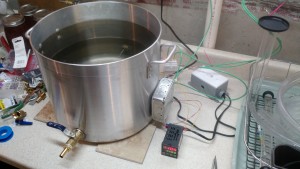
This is the setup. Not perfect, but it works. The switch is for the PID controller (the black box). The SSR is hiding behind the boiler.
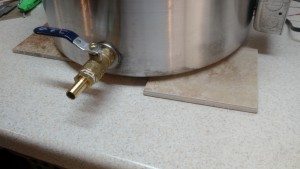
This is my counter protection – 3 6″x6″ ceramic tiles. I don’t think the kettle would damage my Formica countertop, but I don’t want to find out if I’m wrong.
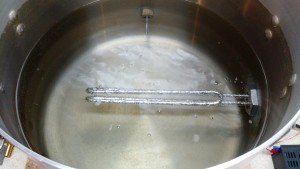
This is the element running and boiling water.
Other Happenings
My cousin was selling a small freezer that would be perfect for us and would replace my current chest freezer with a small upright (and replace a non-energy-star freezer with one that is). Initially I was thinking KEGERATOR!, but after a night’s sleep I thought it might be better to do some fermentation temperature control. That means eventually I will make a schwarzbier, possibly a kolsch, and probably a bock beer early next year.
Cheers!
More Looking at Beer Competitions
In the last few weeks since I first did some data-crunching on a few competitions (the Ohio State Fair, the AHA National Homebrewers Competition, and the Indiana State Fair), two things have happened – the results for the Cincinnati Malt Infusers 2015 All-American Home Brew Competition were released and I read an article about making heat maps, which is a better way to look at this.
Note: green means few, red means many. Colors are proportion of the entries for that competition.
This really just shows the same conclusions I already came to previously:
- American Ale, IPA, and Stout are the most popular categories
- Light Hybrid is a little more popular at the state fairs than the NHC (which can probably be deemed to be somewhat of an average)
One thing the heat map shows is how some styles ebb and flow through time and location. Smoke, sour, and Belgian strong categories really show that.
The other conclusion I came to in the last writing on this subject still applies, too. This doesn’t matter if YOU like the beer you brew.
Cheers!
Friend of Hades IPA Recipe
So I’m starting to experiment with different malts. I started looking into various SMaSH recipes and started seeing people use different base malts. So I decided to base this one on Vienna malt instead of the normal 2-row malt. I also added some carared for color, some carapils for head retention, and crystal 40 for a touch of sweetness and color. I also kicked up the hops quite a bit since my last (extract+partial mash) IPA. The last (also first) IPA I brewed had 7oz of hops (3 oz of Cascade, 2 oz of Citra and Galaxy). This time, I added an extra 3 oz of hops. I also experimented with first wort hopping and steeping (the closest I can get to hopstanding right now).
Here is the recipe.
Recipe Details
| Batch Size | Boil Time | IBU | SRM | Est. OG | Est. FG | ABV |
|---|---|---|---|---|---|---|
| 5 gal | 60 min | 67.7 IBUs | 11.5 SRM | 1.066 | 1.015 | 6.7 % |
| Actuals | 1.051 | 1.01 | 5.4 % | |||
Style Details
| Name | Cat. | OG Range | FG Range | IBU | SRM | Carb | ABV |
|---|---|---|---|---|---|---|---|
| American IPA | 14 B | 1.056 - 1.075 | 1.01 - 1.018 | 40 - 70 | 6 - 15 | 2.2 - 2.7 | 5.5 - 7.5 % |
Fermentables
| Name | Amount | % |
|---|---|---|
| Vienna Malt | 9 lbs | 69.23 |
| Carared | 2 lbs | 15.38 |
| Cara-Pils/Dextrine | 1 lbs | 7.69 |
| Caramel/Crystal Malt - 40L | 1 lbs | 7.69 |
Hops
| Name | Amount | Time | Use | Form | Alpha % |
|---|---|---|---|---|---|
| Cascade | 0.5 oz | 15 min | First Wort | Pellet | 6.6 |
| Cascade | 0.5 oz | 60 min | Boil | Pellet | 6.6 |
| Cascade | 0.5 oz | 15 min | Boil | Pellet | 6.6 |
| Citra | 0.5 oz | 15 min | Boil | Pellet | 12 |
| Galaxy | 0.5 oz | 15 min | Boil | Pellet | 11 |
| Cascade | 0.5 oz | 5 min | Boil | Pellet | 6.6 |
| Citra | 0.5 oz | 5 min | Boil | Pellet | 12 |
| Galaxy | 0.5 oz | 5 min | Boil | Pellet | 11 |
| Cascade | 1 oz | 15 min | Aroma | Pellet | 6.6 |
| Citra | 1 oz | 15 min | Aroma | Pellet | 12 |
| Galaxy | 1 oz | 15 min | Aroma | Pellet | 11 |
| Cascade | 1 oz | 7 days | Dry Hop | Pellet | 6.6 |
| Citra | 1 oz | 7 days | Dry Hop | Pellet | 11 |
| Galaxy | 1 oz | 7 days | Dry Hop | Pellet | 11 |
Miscs
| Name | Amount | Time | Use | Type |
|---|---|---|---|---|
| Irish Moss | 0.25 tsp | 15 min | Boil | Fining |
Yeast
| Name | Lab | Attenuation | Temperature |
|---|---|---|---|
| American Ale (1056) | Wyeast Labs | 75% | 60°F - 72°F |
Mash
| Step | Temperature | Time |
|---|---|---|
| Mash In | 152°F | 60 min |
Download
| Download this recipe's BeerXML file |
Some pics from brewday, all courtesy of Instagram and me being bored:
- First time using First Wort Hops
- Waiting on boil. I need to check my propane burner’s oxygen inlet.
- Mashing in.
- Boiling
The flavor is just what I wanted. A citrus hop rollercoaster. It pours a deep copper color with a thin head. The aroma is mostly orangey (is that a word?). The taste is smooth, very citrusy that lasts for a while. At 67.7 IBU, it’s at the top of the style range, which is pretty much where I wanted it (I looked up the IBU on PsycHOPathy and Truth, both are just over 70). I love it.
Looking at Beer Competitions
I looked into a few homebrewing competitions. I think I mostly wanted to look at how big the categories are.
Data
The data I found is from the National Homebrewing Competition, the Indiana State Fair, and the Ohio State Fair. Only partial datasets were used from the state fairs, because not all the data I need is on their websites. This data is far from perfect, but I think the conclusions I make below are still valid.
Growth
As shown above, there has been a lot of growth in the National Homebrew Competition. From 2009 to 2012, it grew by 50% and by 2014 it grew even more. The states did not show any growth. We’re in a golden age of homebrewing where the Internet helps new homebrewers along, a craft beer surge that shows everyone that not all beer is a Light American Lager. I think this has helped increase the NHC.
Bud’s crack on craft brewing will likely help homebrewing as well as craft beer. After all, 44% of drinkers age 21-27 have never tasted it. Not sure if they’ve had a craft beer either, though (they could be wine or whiskey drinkers).
Styles
I visually looked through to see the top five and bottom five. I didn’t do any actual analysis other than that.
Top 5: American Ale, IPA, Stout, Belgian and French, and Belgian Strong
It is probably expected that American Ales and IPAs would be big styles. I think a lot of people that ‘stick their foot in’ to craft beer start with amber or pale ales and probably soon make it to IPAs. After being in the hobby for 6 months, I’m not shocked to see strong numbers from Stout – it seems like the non-hop-head craft beer lovers gravitate towards good stouts. Also, Stout allows for some flexibility with ingredients without becoming something not-beer. I’m also not shocked to see Belgian and French, and Belgian Strong classes represented well, as many of the homebrewers I know have a profound interest in those two classes (specifically in saisons, tripels, and quadrupels).
Bottom 5: Amber Hybrid, Strong Ale, Sour Ale, Euro Amber Lager, and Dark Lager
Amber Hybrid (which includes Northern German Altbier, Dusseldorf Altbier, and California Common) is one I would have expected to be higher, although that is mostly because of the California Common style. BYO Magazine recently did a feature article on this, perhaps we’ll see some growth there. As far as altbier, I’m not sure my three local bottle shops have any altbier that would be within these styles. I don’t know about others, but I’d sure be apprehensive of brewing a style I’ve never tasted.
Strong Ale was a little shocking. I expected more people to use barleywine to show off malt selection.
I didn’t think it was shocking that sour ale was among the bottom, but maybe that’s because I find them intimidating from the brewing standpoint.
I was shocked to see both the Euro Amber Lager and Dark Lager among the bottom five. These two style groups include some of my favorites in the lager kingdom, Oktoberfest and Schwarzbier.
From my point of view on one of the hills east of Cincinnati, though, I am partially not shocked about all but one of the bottom 5 being lagers. According to the temperature on my ale pail, fermentation holds around 64-66 degrees (Fahrenheit, 18-19 Celcius) in my basement with no temperature control. Perfect for ales, not so much for lagers. I eventually will brew some lagers, but I have to have better temperature control first.
An interesting contrast in the styles is the light hybrid group. Apparently this is pretty common in the midwest, but not nationally – it’s pretty low for NHC, but pretty high for both the state fairs. This includes cream ale, blonde ale, Kolsch, and american wheat or rye. My only guess here is that we have a local soft spot for Little King’s Cream Ale.
Growth and Losses
I looked at this by looking at the slope of the trend based on the NHC data.
The biggest growth style classes are IPA, American Ale, Stout, Belgian and French Ale, and Spice, Herb, and Vegetable Beer. I don’t find any of these shocking except the spice, herb, and vegetable class.
The losing classes are all meads. I’m not sure what to think of that. On one hand, it isn’t uncommon to find a homebrewer that is at least interested in fermenting mead. On the other hand, good honey is incredibly expensive, and that may factor into things.
The not-really-growing classes are Pilsner, Specialty Cider & Perry, German Wheat & Rye, Light Lager, and Standard Cider & Perry. Regarding cider and light lager, I’m not shocked. While I don’t think the hobby is bent against ciders, perries, and light lagers, I think there is a segment of beer drinkers that look on those three groups as being inferior. I don’t agree with them (and I have a cider experiment going on in the basement now), but I think it exists.
That leaves Pilsner and German Wheat & Rye as the odd men out. I’m not sure why, as every beer geek worth his (or her) glass knows that Pilsner is different from Light Lager (and generally regarded as far better). Perhaps it has to do with the difficulty in water chemistry and fermenting. Regarding German Wheat and Rye, I don’t know. It’s not among my favorite styles, but that doesn’t really mean anything to others.
So What’s This All Mean?
Nothing. Nada. Jack Shit. I’m a data geek in real life and wanted to look into this. Awards don’t matter, your taste does. Brew what you like, because if you come in from work and look forward to opening another homebrew, you’re doin’ it right.
…but I understand if you still want to win an award (I do). It’s kinda like getting a medal at the end of a (running) race. The medal symbolizes the work that went into training for that event. Similarly, a beer award symbolizes the work put into formulating and executing a recipe.
Cheers!
Building a Mash Tun
A few weeks ago (and I think I posted something quick about it here), I bought a 12 gallon cooler to be used as a mash tun. Over the past week and weekend, I started getting it together.
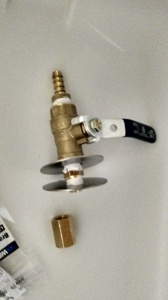
This is sort of the way things went together. I did add some exterior caulk between the internal washer and the cooler to provide a water-tight fit (and I tried several times to not use the caulk, but there seemed to be no way to do that without ending up with a leak).
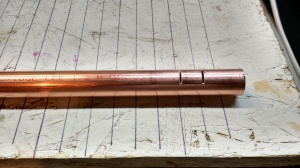
Starting on the copper for the drain lines. This is clamped down (gently!) on one end and I drew lines on my workbench at 1/2″ intervals to speed the process of sawing the slots.
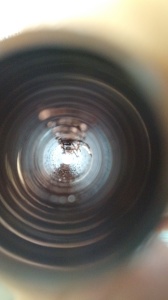
Interior of the lines before cleaning. I found that a 1/2″ drill bit fit through the 1/2″ copper, so I ran it through a few times to remove the burrs.
Beer Update
The IPA is probably ready to be bottled, but I spent all my time doing yard work, building my mash tun, and fixing a Christmas tree stand that nearly sent a tree tumbling last year (She Who Must Be Obeyed was NOT happy about that!).
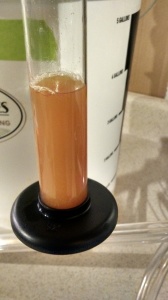
The color is lighter, probably because I added the DME near the end, but I was still looking for lighter. I’ll also want to get it clearer.
First Homebrew Bottled!
It’s been two weeks (at the time I’m typing this) since I brewed the very first batch. I’ve learned a ton since brewing, and a ton since trying to do things like check gravity. On that last thought, I bought a wine thief to make checking gravity easy, but even after getting acclimated to using it.
September 19, 2014: Checked gravity, got 1.014. Tasted beer. Initial flavor very citrusy (specifically orange), followed by a bitter slam.
September 21, 2014: Checked gravity, got 1.012. Tasted beer. Citrus flavor more subdued, and bitter slam gone.
September 22, 3014: Checked gravity, got 1.010.
September 23, 2014: Checked gravity, got 1.010. Ready for bottling!
I don’t know if bottoming out the wine thief on the bottom of the ale pail made any difference, but the flavor change after ~36 hours was pretty substantial. I had a ton of stuff to do on September 21, so the gravity change was well timed.
In other news, I was given birthday money (kinda weird feeling to still get birthday money when you’re 36), but I decided to spend it on a handful of homebrew things – a cooler to be used as a mash tun, a spare airlock, another lid (since I’m using my bottling bucket for sanitizer for now and want a lid on it to keep dust out), and some tube. Through reading one of the forums or Reddit or something, I saw someone post that they use a spray bottle of sanitizer with things like checking gravity (when removing the lid). I decided that I should do the same.
In addition to buying more stuff, I cleaned up an area in my basement that will ultimately be used for brewing. I do want to get an electric boiling kettle that I can use down there as opposed to using my stove. I also want to build an exhaust hood that would cover that area so when I’m boiling I can exhaust the steam as opposed to letting it go through the house – this is especially important in my basement as there is no air return duct in the basement, only a supply duct.
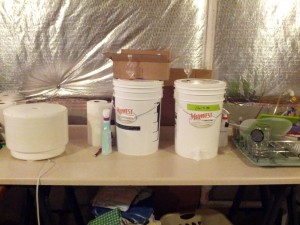
The food dehydrator is dehydrating hot peppers, which is why there is an airlock on the bucket marked ‘sanitizer’.
Bottling Day
There’s not much to talk about with bottling except that I was reminded of something – that little hole on the bottling bucket spigot is important.
Cheers!
New Brewing Prep
I intend to post weekly, and this has been revised at least five times. I hope it is still a coherent post.
I have been figuring out what I need and what I want to do relative to actually brewing beer, and with the help of various posts on various forums, I think I figured out that I am going to start with a starter set that includes a fermenting bucket, bottling bucket, glass carboy, and I think all the tools to make things work. I had settled on it a few days before Labor Day and while browsing the Reddit homebrewing forum late on Monday night I saw a post that indicated most things at that particular webstore were 10% off, so I ‘pulled the trigger’. Happy birthday to me a few weeks early :-). For whatever reason, the “in stock” item didn’t ship until 9/4 late in the evening. It took so long for them to ship the in-stock item that I thought maybe they know that my birthday is around two weeks away and they’re shooting for that to be delivery day. Truthfully, for a first experience it isn’t good (which is why I’m going into great depth to NOT give away who they are, although if they screw up twice the gloves are coming off). I will probably give them another chance, as it’s my first experience and whatnot, but I might be apprehensive of ordering something that I need in a week and probably reserve their second chance for something that I can order two or three weeks out.
There is one shining spot of it – UPS has been getting the 43 pound set from the middle of the country to Ohio at a record speed – within 16 hours (which includes an overnight), they made it from the origin to Toledo, Ohio. They’re trying like Hell (and will most likely be successful) at getting it to me on Monday. Conveniently right after the weekend. Of course it could have been here Friday if it was shipped a day sooner.
In addition to the supplies, I stopped by a local retailer (I don’t want to call them a homebrew shop, since they’re a large eclectic grocery store that happens to have some homebrewing supplies as well as one of the best beer stocks in the region). I quickly located and purchased the LME, DME, yeast, and hops. However, I was a bit disappointed in the hops selection. I was able to find Soriache Ace (bittering) and Cascade (aromatic) hops, but there was a lot of Cascade and some other varieties of almost all aromatic hops – very few bittering hops. Their refrigerator was mostly bare. I’m going to check them again and see if it was just that they had a lot of purchases prior to Labor Day. I also want to check another local homebrew shop or two.
In the meantime, I’ve been saving and washing a lot of bottles. I’ve been on the lookout for “Grolsch Style” bottles, but haven’t found any Grolsch lately (and the last place I bought it at appears to no longer carry it, although they do have the bottle in the picture below). I think I’d prefer those to having to cap bottles, but I know I’m probably going to be using normal bottles for the first batch. And the second. Probably the third too. Most likely even the fourth.
I did wash and remove the painted labels from four Stone bottles. Using the hint provided on Home Brew Talk, I soaked the bottles in Star San (prepared according to the label on the back) for around 22 hours. I was able to wipe all the paint off the Stone IPA bottles with a damp rag. Same with everything that wasn’t blue on their Self Righteous IPA. And the same with everything that wasn’t gold on their Ruination (there is, unfortunately, a lot of gold on those bottles). However, I decided I’d try something abrasive (which happened to be a bar of Lava soap since I was at my utility sink) and it started taking gold off a Ruination bottle, so I took a dish scrubbing pad to those bottles and that took the remaining paint off.
I’m up to around 30 bottles currently, and I probably won’t be bottling my first batch until early October, so I’m probably going to have enough by the time bottle day rolls around. And I’m already dreaming of a keg system and one of those conical fermentors that I’ll probably never actually get in real life.
I’ve already decided my first brew will be the Cincinnati Pale Ale as included on John Palmer’s Website. First off, I live in Cincinnati (a wonderful place to live if you like beer, thanks to Rhinegeist, MadTree, Moerlein, and other breweries), and I like Pale Ales. I will use extracts (mostly because this is my first and I want to make it easy on myself), but I likely will not be using a kit for ingredients because I want control over what I get. I think at some point in the future I will go all-grain, but walk before run.
One thing I think I will be doing prior to brew day is figuring out every little detail for brew day from where things will sit and what will be where when it is used. I figure it might be a smart thing to make sure I don’t get into a position where I have to carry a 30-pound+ vat of boiling wort halfway across the house to dump it into the fermentor… or have to hunt for the fermentor.
/A
